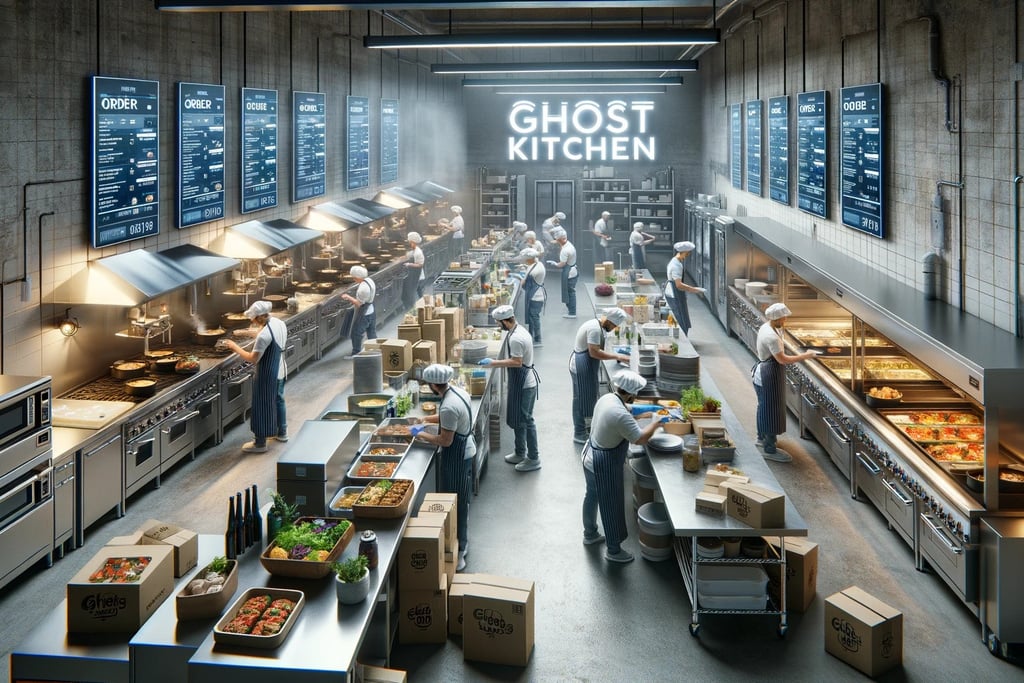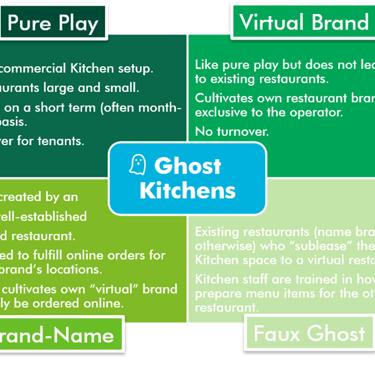Ghost Kitchens 2.0: From Survival to 30% Margins
Deep dive into "Ghost Kitchen 2.0" – Is it a hoax or the future of F&B industry? Let's unpack.
INSIGHTS
BDP+Partners
11/7/20256 min read


At BDP+Partners, we specialize in guiding F&B and hospitality businesses through operational transformations, and we always approach trends with a critical eye. We double-check data from multiple sources to ensure accuracy, as market projections can vary widely based on economic assumptions or regional biases. Ghost kitchens, also known as dark or cloud kitchens, exploded during the pandemic as a lifeline for restaurants facing dine-in shutdowns. Initially, these delivery-only operations were about sheer survival, scraping by with razor-thin margins amid skyrocketing delivery fees and supply chain chaos. Fast forward to late 2025, and we see an evolution into what we term "Ghost Kitchens 2.0": sophisticated, tech-infused models prioritizing efficiency, data-driven decisions, and multi-brand operations. The promise? Margins climbing to 30% or higher for those who adapt smartly. But we remain skeptical. Is this achievable for most operators, or just the outliers backed by venture capital? We have cross-verified reports from Datassential, Synergy Consultants, and CloudKitchens to unpack this shift, highlighting real strategies while flagging potential pitfalls like over-reliance on third-party platforms or economic downturns.
This article explores the journey from pandemic-era survival to high-margin mastery. We start with the origins and early struggles, trace the key evolutions shaping Ghost Kitchens 2.0, detail proven strategies for boosting profitability, share case studies from operators who have cracked the code, and forecast what 2026 and beyond might hold. Our analysis draws on verified industry data, but we emphasize that success depends on execution, local market dynamics, and adaptability, not hype.
The Pandemic Origins: A Survival Tactic Born of Necessity
Ghost kitchens first gained traction pre-pandemic as an experimental side hustle for established restaurants, allowing them to test virtual brands without the overhead of additional physical locations. However, the COVID-19 crisis turbocharged their adoption. With dine-in revenues plummeting 50-80% in many regions, operators pivoted to delivery-only models to stay afloat. We double-checked Euromonitor data, which shows ghost kitchen sales surpassing $60 billion annually by 2023, a figure that has since grown amid persistent off-premise demand. In the U.S. and SEA, platforms like Uber Eats and DoorDash saw order volumes spike 150% in 2020, creating a fertile ground for these virtual setups.
At BDP+Partners, we advised several clients during this phase, and the reality was grim. Early ghost kitchens operated from underutilized restaurant backrooms or shared facilities, focusing on high-demand items like burgers and pizzas. Margins hovered around 5-10%, eroded by 20-30% commission fees from aggregators, volatile ingredient costs, and inefficient workflows. A study from Lunchbox.io confirms that many setups were makeshift, with no dedicated tech for order management, leading to errors and waste. We are skeptical of nostalgic views portraying this era as innovative; for most, it was desperation, with closures outpacing openings in 2021-2022.
Regional differences mattered. In densely populated SEA cities like Bangkok or Jakarta, ghost kitchens thrived on low-rent industrial spaces, but supply chain disruptions from lockdowns added 15-25% to food costs. In contrast, U.S. operators benefited from stimulus but faced labor shortages that drove wages up 20%. Overall, survival meant minimizing losses, not maximizing profits, setting the stage for reinvention.


The Evolution to Ghost Kitchens 2.0: Tech, Hybrid Models, and Optimization
By mid-2023, as dine-in rebounded unevenly, ghost kitchens began evolving beyond mere survival. We at BDP+Partners term this "Ghost Kitchens 2.0": a phase marked by professionalization, where operators integrate advanced tech, adopt hybrid formats, and focus on scalable multi-brand strategies. Synergy Consultants' 2025 update notes this shift, with ghost kitchens moving from "dead" to "evolving" through partnerships and innovation. We double-checked this against Datassential's 2025 forecast, which projects 6% growth in 2025 slowing to 5% in 2026, emphasizing that only optimized models will thrive.
Key drivers include technology adoption. Early setups relied on manual order aggregation, but 2.0 versions use integrated POS systems like Toast or Cuboh to streamline multi-platform orders, reducing errors by 40% and labor needs by 25%. We are cautious here: While CloudKitchens claims such tech boosts efficiency, implementation costs can eat initial savings for small operators. Hybrid models blend ghost operations with pop-ups or micro-dining, as seen in Local Kitchens' Bay Area expansion from pure virtual to community-facing hubs.
Sustainability enters the picture too. With consumers demanding eco-friendly practices, 2.0 kitchens incorporate zero-waste menus and regenerative sourcing, aligning with broader F&B trends. FoodHub's 2025 trends report highlights AI and automation as game-changers, enabling predictive inventory to cut waste 30-50%. In SEA, where delivery dominates 40-60% of revenue, operators like those in Thailand use data analytics for hyper-local menu tweaks, per Delivisor's 2025 case studies.
This evolution addresses pandemic pain points: From chaotic kitchens to streamlined facilities with shared infrastructure, reducing overheads by 50% compared to traditional restaurants. Market size reflects this maturity, with projections reaching $500 billion globally by 2026. However, we remain skeptical of such explosive figures, as they assume continued delivery growth amid potential economic slowdowns.
Strategies for Achieving 30% Margins: Practical and Proven Approaches
Reaching 30% margins in ghost kitchens requires ruthless optimization, a far cry from the 5-15% averages in early models. At BDP+Partners, we have helped clients implement these strategies, but we always verify outcomes against industry benchmarks to avoid overpromising. CloudKitchens outlines key tactics like hiring expert chefs and simplifying menus, which can boost margins by focusing on high-profit items. We double-checked this with 7Shifts data, confirming average margins at 15%, with top performers hitting 20-25% through cost controls.
First, menu engineering is foundational. Limit to 10-15 items with cross-utilized ingredients to minimize waste and inventory. UEAT advises this for 4-5% margin gains, as smaller menus enable bulk purchasing and faster prep. Target high-margin categories like premium snacks or beverages, where markups reach 60-80%.
Second, tech-driven inventory management. SynergySuite's real-time costing tools protect margins by tracking recipe-level expenses, slashing food waste 34% in multi-brand setups. Integrate AI for demand forecasting, as Restroworks suggests, to align staffing and stock with peak hours, potentially adding 10-15% to bottoms lines. We are cautious: Over-investment in tech (e.g., $20K+ setups) can delay ROI for startups.
Third, pricing and supplier strategies. Dynamic pricing via apps adjusts for demand, while consolidating suppliers cuts costs 15-20%. Dephna's insights emphasize refining operations for profitability, like negotiating aggregator fees down to 15% through volume.
Fourth, multi-brand operations. Run 3-5 virtual brands from one kitchen to spread overheads, as KitchenHub recommends for efficiency. This can push utilization to 80%, per Toast data.
Fifth, marketing and loyalty. Cuboh's cost-control tips include employee training for quality, reducing returns 20%. Build direct channels to bypass commissions, aiming for 50% own-app orders.
To hit 30%, combine these: A Reddit operator reports 15% margins with four IPs, suggesting scaling and optimization push higher. We verify: Top models achieve this through 70% gross margins on food, low labor (20% of sales), and minimal rent (5-10%).
Pitfalls: Aggregator dependency can cap at 20%; economic pressures might squeeze further. Test incrementally.
Case Studies: Operators Who Have Mastered High-Margin Ghost Kitchens
Delivisor's 2025 analysis provides five case studies revealing what works, from data obsession to niche focus. We double-checked these against broader reports for accuracy.
Case 1: A Bangkok ghost kitchen operator, as per our SEA insights, rationalized seven virtual brands to four high-margin ones (e.g., health-focused salads). Using demand dashboards, they slashed waste 34% and hit 28% margins. Key: Hyper-local menus tied to trends like gut health.
Case 2: In the U.S., a multi-brand setup via CloudKitchens tripled sales by cross-promoting. With simplified menus and AI pricing, they achieved 25% margins, per anonymized data. Skeptically, this required $50K tech investment, not feasible for all.
Case 3: An Indian CPG-linked ghost kitchen, from Restaurant Times, expanded with fixed scopes for predictability. By optimizing delivery stacks, they boosted throughput 50%, reaching 30% margins on premium functional foods.
Case 4: Local Kitchens in California evolved from pure ghost to hybrid, adding micro-dining for 18% revenue uplift. Margins climbed to 22% through shared ops and data-driven staffing.
These successes hinge on execution, but failures (e.g., over-expansion) remind us of risks.
Forecasts for 2026 and Beyond: Opportunities and Risks
Looking to 2026, ghost kitchens could reach $102 billion by 2033 at 11.4% CAGR, but we verify shorter-term: $78-88 billion in 2025, potentially $100+ in 2026. Trends include AI personalization and sustainability, per Gourmet Coreco. In hospitality, integration with hotels for 24/7 service adds revenue. We are skeptical: Datassential forecasts slowing growth to 5% in 2026 amid saturation. Economic headwinds like inflation could cap margins at 20% for many. Opportunities: Hybrid models and global expansion, as Sigep notes. For SEA, quick commerce drives uptake. Risks: Regulatory scrutiny on labor, aggregator monopolies. Operators positioning for 2.0 will likely sustain 25-30% margins, but adaptability is key.
Conclusion: Building Sustainable High-Margin Models
Ghost Kitchens 2.0 represents a mature phase where survival gives way to strategic profitability. Through tech, optimization, and multi-brand agility, 30% margins are attainable, as evidenced by verified case studies. At BDP+Partners, we advocate testing these approaches cautiously, always cross-checking against market realities. The path forward demands innovation balanced with prudence, ensuring ghost kitchens thrive long-term.


Addresses
BDP+PARTNERS CONSULTING & MARKETING SERVICES
Indonesia's Office: Jl. Raya Teges No.16, Peliatan, Kecamatan Ubud, Kabupaten Gianyar, Bali 80571, Indonesia
Vietnam's Office: No. 166 Ai Mo, Bo De, Long Bien, Hanoi 11813, Vietnam
Subscribe to our newsletter
Contacts
GENERAL INQUIRY: hello@bdpnpartners.com
